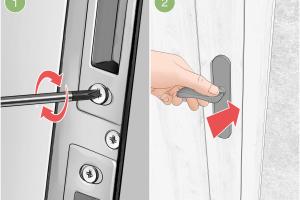The Ultimate Pro's Guide to Adjusting a uPVC Door: Tips & Tricks

-
Quick Links:
- Introduction
- Understanding uPVC Doors
- Common Issues with uPVC Doors
- Tools Needed for Adjusting uPVC Doors
- Step-by-Step Guide to Adjusting uPVC Doors
- Case Studies
- Expert Insights
- FAQs
Introduction
When it comes to home improvement, adjusting a uPVC door may seem daunting. However, with the right guidance, anyone can master this essential skill. Whether you're facing issues with alignment, locking mechanisms, or wear and tear, this comprehensive guide will provide you with all the necessary tools and knowledge to adjust your uPVC door like a pro.
Understanding uPVC Doors
uPVC (unplasticized polyvinyl chloride) doors are popular for their durability, energy efficiency, and low maintenance. However, like any door, they can experience wear over time. Understanding the structure and components of a uPVC door is crucial for effective adjustments.
Components of a uPVC Door
- Frame
- Hinges
- Locking Mechanism
- Seals
Common Issues with uPVC Doors
Before making adjustments, it's essential to identify the common problems that may arise with uPVC doors:
- Misalignment: The door may not close properly or may stick.
- Weather Stripping Damage: This can lead to drafts and reduced energy efficiency.
- Locking Issues: The lock mechanism might fail to engage or disengage smoothly.
Tools Needed for Adjusting uPVC Doors
To adjust a uPVC door, gather the following tools:
- Phillips screwdriver
- Flathead screwdriver
- Allen key set
- Spirit level
- Measuring tape
- Lubricant spray
Step-by-Step Guide to Adjusting uPVC Doors
Follow these detailed steps to adjust your uPVC door effectively:
Step 1: Inspect the Door
Begin by inspecting the door for any visible issues such as gaps, misalignment, or wear on components.
Step 2: Check the Hinges
Using a Phillips screwdriver, tighten any loose screws on the hinges. If the door is sagging, you may need to adjust the height using the allen key.
Step 3: Adjust the Locking Mechanism
Check the alignment of the locking mechanism with the strike plate. You can adjust the strike plate by loosening the screws and repositioning it as needed.
Step 4: Align the Door
Use a spirit level to ensure that the door is perfectly vertical. Adjusting the hinges will help achieve this balance.
Step 5: Lubrication
Apply a silicone-based lubricant to the hinges and locking mechanism to ensure smooth operation.
Case Studies
In this section, we will analyze real-world examples where homeowners successfully adjusted their uPVC doors, highlighting the techniques used and the challenges faced.
Case Study 1: The Sagging Door
A homeowner found that their uPVC door was sagging and not closing properly. After following the adjustment steps, they successfully tightened the hinges and realigned the door, restoring functionality.
Case Study 2: Locking Mechanism Failure
Another case involved a door lock that was difficult to operate. By readjusting the strike plate and lubricating the mechanism, the homeowner improved the door's security and ease of use.
Expert Insights
Industry experts recommend regular maintenance checks on uPVC doors to prevent issues from becoming severe. They also suggest using high-quality lubricants to prolong the life of door components.
FAQs
1. How often should I adjust my uPVC door?
Regular checks, at least twice a year, are advisable to ensure optimal performance.
2. Can I adjust a uPVC door myself?
Yes, with the right tools and guidance, adjusting a uPVC door can be a manageable DIY task.
3. What tools do I need for adjusting a uPVC door?
You'll need a Phillips screwdriver, flathead screwdriver, allen key set, spirit level, measuring tape, and lubricant spray.
4. What causes a uPVC door to become misaligned?
Factors like temperature changes, wear over time, and improper installation can lead to misalignment.
5. How can I tell if my door is sagging?
If the door does not close properly or if there are visible gaps when closed, it may be sagging.
6. Is it necessary to replace the entire door if it won’t adjust?
Not necessarily. In many cases, issues can be fixed with adjustments or replacing specific components.
7. What type of lubricant is best for uPVC doors?
A silicone-based lubricant is recommended for its durability and effectiveness.
8. Can weather changes affect my uPVC door's performance?
Yes, temperature fluctuations can cause the materials to expand or contract, affecting alignment.
9. What should I do if I can't adjust the door myself?
If you're unable to fix the issue, it might be best to consult a professional for assistance.
10. How long should uPVC doors last?
With proper maintenance, uPVC doors can last up to 30 years or more.
Random Reads
- How to install crouton on your chromebook
- How to install desmume emulator
- How to hear audio from remote pc
- How to have more than eight family members in sims 2
- How to print text messages from iphone
- How to prevent clean rust off metal
- Mastering airplay
- Mastering agar io
- How to stop buffering
- How to stipple ceiling